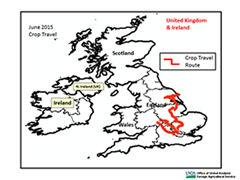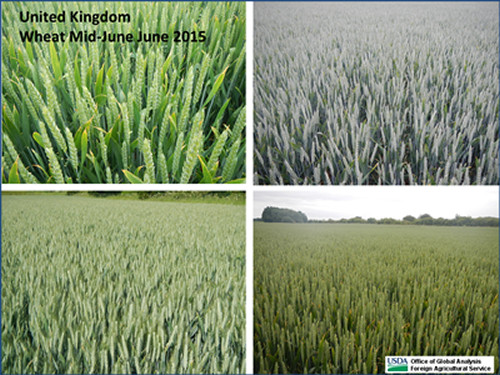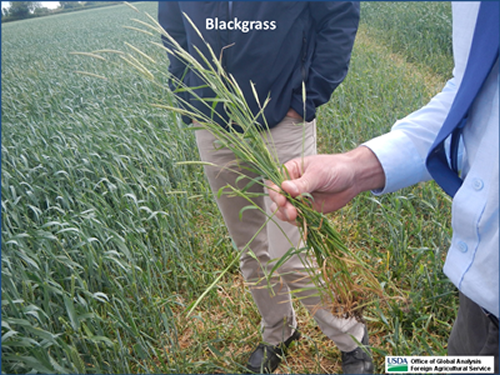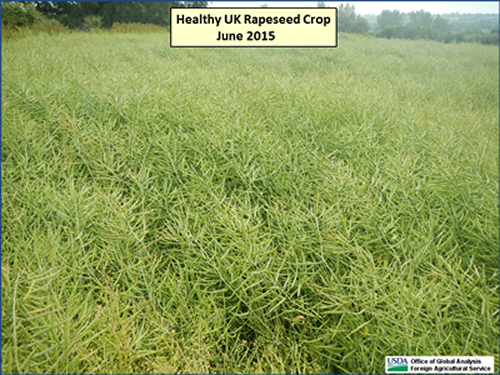United Kingdom: Crop Production Report
Crop Production
USDA estimates 2015/16 United Kingdom (UK) wheat at 15.3 million metric tons (figure 1); barley at 6.8 million tons, oats at 0.7 million tons. The only significantly produced oilseed in the UK is rapeseed, with 2015/16 production estimated at 2.2 million tons (figure 2). The UK is the third largest wheat producer in the European Union (EU) (figure 3) and the fourth largest in rapeseed output (figure 4). The UK’s five-year average wheat yield of 7.61 tons/hectare (T/Ha) is among the EU’s highest. The most significant grain crops in the UK are wheat, barley, and oats. For the UK or other EU member-state area and production totals, please download the EU Countries Area & Production file at: https://apps.fas.usda.gov/psdonline/psdDownload.aspx

Staff from USDA –Foreign Agricultural Service (FAS) Washington and London – traveled through the major grains and oilseeds region of the United Kingdom (UK) during June 2015. (see map, figure 5). All of the primary crops – wheat, barley, and rapeseed appeared in good condition during the tour.
Climate
Agriculture in the United Kingdom (UK) benefits from relatively mild temperatures and reliable precipitation. The maritime climate affords the UK a long growing season but it also deprives it of substantial summer heat. The extended growing season and UK’s famously cool and damp climate is particularly conducive to autumn planted crops, regularlyly ensuring high yields for winter wheat and rapeseed. UK winter wheat yields are among the highest in the world, with yield for 2015/16 estimated at 8.05 T/Ha. UK winter wheat yield is fourth highest in the world only below the estimated yields in the nearby countries of the Netherlands, Belgium-Luxembourg, and Ireland. Last year, UK wheat yields achieved a record 8.58 T/Ha (figure 1). However, the cool climate, limits summer crop selections. The UK has one of the smallest mixes of crops in Europe, but the crops that are grown have some of the continent’s best yields. Soil quality throughout much of the primary growing area, located in the east of England, is rich, heavy and excellent for water retention. Because of the lack of extreme temperatures and precipitation, annual UK yields vary little relative to other European national yields.

Figure 6 United Kingdom Wheat mid-June 2015.
Wheat
Winter wheat is planted in October and harvested in mid-to late September. During the crop tour in mid-June, the 2015/16 crop was finishing the flowering and reproductive stage (figure 6). Unlike much of continental Europe which suffered from summer drought, rainfall in the UK had been adequate, even though somewhat less than ideal.
While UK’s 2015 summer was drier than normal, in general, the combination of England’s frequent showers and heavy soils provided agreeable conditions for wheat growth. Although June rainfall is critical for adding weight to filling grains, several farmers mentioned that solar radiation (or sunshine} during June is most important for yield formation. Unfortunately for UK farmers, sunshine in June can be rather elusive. This problem was particularly apparent during 2012 when plentiful rains made for promising yield expectations. Expectations however, were not met because of a lack of sunny June days which prevented grain enlargement. Yields in 2012/13 were 6.66 tons per hectare (T/Ha), the lowest since 1989/90, compared to this year’s estimated 8.05 T/Ha (figure 1). Optimally, a combination of sunny and rainy days in June at flowering and grainfill helps the crop attain full yield potential.

Figure 7 Blackgrass in wheat fields
Blackgrass
Agricultural experts raised some concern for this year’s crop during discussions. The recent proliferation of the weed blackgrass (figure 7) was on the mind of every farmer we met. While it wasn’t dominant in most fields and the overall national wheat yield should remain little changed because of it, blackgrass was well established in some fields and almost everyone has a fear of it spreading to theirs. (figure 8, figure 9). Left alone, the weed would continue to spread throughout the field, reducing the wheat population and competing with it for nutrients, particularly nitrogen. Yield reduction in individual fields could range from 0.5 T/Ha up to 2.0 T/Ha.
Blackgrass has many similarities to wheat and thus has proven difficult to control (figure 10). It competes with wheat for space, sunlight and water. While having been in the UK for a long time, it is thought to have recently spread more quickly due to a combination of increased restrictions on chemical inputs and limited crop rotation practices. In recent years many farmers have reduced their cropping mix to just wheat and rapeseed, often the most profitable combination. Minimal tilling is also thought to have increased the spread of blackgrass because the seeds are not plowed.
Back to the Basics with More Crop Rotations
Farmers and agricultural experts frequently expressed their concern about a lack of effective, available chemical herbicides and pesticides for use in their fields. With legislative restrictions on chemical inputs in the EU, and a ban on burning crop stubble, it appears that it will be back to the basics for UK farmers with more crop rotations as the best alternative to help fight weeds and pests. The EU’s Common Agricultural Policy (CAP) recently mandated that EU farmers with ten or more hectares must plant at least three crops to ensure diversity.
The addition of one or more crops into the rotation seems to be the most promising solution and the likely outcome that most farmers will take to control blackgrass. An additional crop of spring barley in the rotation adds both plant diversity and temporal diversity, making it more difficult for blackgrass to become established. Most farmers stated that spring barley (figure 11) is the obvious choice and an increase in spring barley acreage is likely to continue. Blackgrass predominately emerges in the fall so spring barley could emerge on a sprayed and clean field without as much competition as winter wheat would have in the autumn. About half of the barley throughout the UK is spring variety and almost all of the barley in the north and in Scotland is spring planted. Other crops that could be used in rotation include pulses (peas, fava beans and other beans), and grasses (such hay and alfalfa).The UK also grows a significant amount of sugar beets and potatoes, which might also work well in rotation.

Figure 12 Healthy United Kingdom rapeseed
Rapeseed
Rapeseed (figure 12) is typically planted in August and harvested about a year later, in August or during the beginning of September. For effective pest management the crop should not be planted in the same field more than once every three years but due to profitability its rotation in some farms has been increased to once in every other year.
Flea Beetle
In 2013 the EU implemented a ban on neonicotinoid insecticides to help stabilize the bee population. The cabbage stem flea beetle is the pest that farmers fear will benefit most from the ban, and rapeseed may be the most affected crop. The beetle’s larvae enter by tunneling into a stalk, often destroying the plant or leaving it weakened and vulnerable to disease. The rapeseed fields that had flea beetle damage had stunted plants and dense stands of weeds (figure 13). While the damage was severe in local fields, flea beetle has so far caused minimal widespread damage.
Hedgerows—A Historical Legacy
An additional challenge to UK farmers includes maintaining (including trimming) the ubiquitous, protected hedgerows (figure 14) and the land buffers around them. These roughly two meter wide (or more) linear barriers are rather common to the UK, Ireland, and parts of France. In order to sustain wildlife diversity, and for producers to qualify for additional support, crops cannot be planted within these buffered zones. These protected rows can add up to a significant amount of unplanted area, particularly to local farmers who have several of them in their fields.
References
This report has been published by the Office of Global Analysis (OGA), International Production Assessment Division (IPAD). Current USDA area and production estimates for grains and other agricultural commodities are available at PSD Online. For individual EU member state production amounts, please download the EU Countries Area & Production file at: https://apps.fas.usda.gov/psdonline/psdDownload.aspx
Current USDA area and production estimates for grains and other agricultural commodities are available on IPAD's Agricultural Production page or at PSD Online.
Visit Crop Explorer http://www.pecad.fas.usda.gov/cropexplorer/
|

